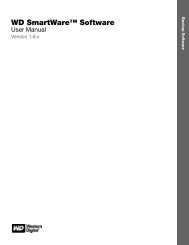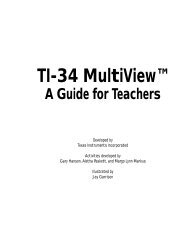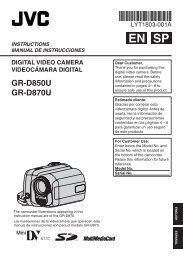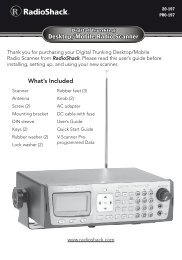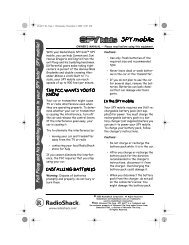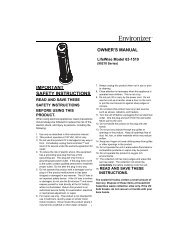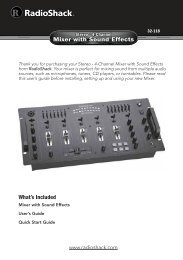Digital Trunking â Desktop/Mobile Radio Scanner - Radio Shack
Digital Trunking â Desktop/Mobile Radio Scanner - Radio Shack
Digital Trunking â Desktop/Mobile Radio Scanner - Radio Shack
You also want an ePaper? Increase the reach of your titles
YUMPU automatically turns print PDFs into web optimized ePapers that Google loves.
Understanding your <strong>Scanner</strong><br />
managed automatically by a special computer, called a controller, or<br />
by other specialized hardware. If you want to monitor a talkgroup on<br />
a trunked radio system, you must store that talkgroup’s parameters in<br />
a TGRP object.<br />
TSYS – <strong>Trunking</strong> System Object<br />
A TSYS is a special object type that is used when creating TGRP<br />
objects. A trunking talkgroup must be associated with a specific<br />
trunked radio system in order for it to operate. There are parameters<br />
that are associated with trunking systems, such as the type of trunked<br />
radio system technology used, the frequencies that the system uses<br />
to broadcast control data, etc. Instead of entering these parameters<br />
over and over again every time you create a new TGRP, you create<br />
a TSYS object with all of the system parameters, then specify that<br />
TSYS object for each TGRP you create on the same trunked radio<br />
system. A TSYS cannot be scanned by itself and is not considered<br />
a Scannable Object. It is a “configuration object” that can be used<br />
over and over again when adding talkgroups for a specified trunked<br />
radio system.<br />
LMIT – Limit Search or Search Range Object<br />
LMIT objects contain the parameters necessary for the radio to<br />
search a range of individual frequencies between a lower and upper<br />
limit frequency.<br />
SRVC – Service Search Object<br />
SRVC objects are further divided into Public Safety, Aircraft, Amateur,<br />
CB, Marine, and FRS/GMRS/MURS/DOT. SRVC objects are similar<br />
to LMIT objects, but are preprogrammed to search all frequencies<br />
associated with the selected service.<br />
STLK – Signal Stalker II Object<br />
STLK objects contain the parameters necessary for the radio to<br />
rapidly sweep a range of radio spectrum for strong signals from<br />
nearby transmitters.<br />
<strong>Scanner</strong> Features<br />
Understanding your <strong>Scanner</strong><br />
Object Oriented User Interface is designed for ease of use, yet is<br />
powerful enough to satisfy the most sophisticated experts. Common<br />
data entry, browsing and control methods are used for non-trunked<br />
conventional channels, trunking talkgroups, search configurations and<br />
Signal Stalker II setups. The radio grows with you—you can start out<br />
with a small, easy to manage configuration, then expand it whenever<br />
you need to.<br />
Menu Driven Programming with Context Sensitive Help – Each<br />
menu item provides a few lines of help text that provide assistance<br />
with programming and using the scanner.<br />
Scan List functionality allows you to arrange, group and scan objects<br />
according to your preference.<br />
Free-Form Memory Organization – Memory is assigned as objects<br />
are created using a sophisticated internal file management system.<br />
You are not constrained to traditional bank or channel scanner<br />
memory layouts. The scanner can store over 1,800 conventional<br />
channels, trunking talkgroups, search configurations, and Signal<br />
Stalker II objects in any combination.<br />
V-<strong>Scanner</strong> Technology – Allows you to save complete radio<br />
configurations within the radio, for recall into main memory as<br />
needed in the field. Twenty one V-<strong>Scanner</strong> Folders are provided,<br />
each capable of storing over 1,800 objects. Total memory capacity of<br />
main memory combined with V-<strong>Scanner</strong>s is over 37,800 objects.<br />
Skywarn Storm Spotter Functionality – Instant access to<br />
frequencies used by storm spotter networks. You can monitor<br />
storm conditions as they occur, and become aware of dangerous<br />
conditions before the media or emergency management officials<br />
announce them to the general public.<br />
SAME and All Hazards Weather Alerting – Your scanner can<br />
alert you to severe weather and other hazards in the specific areas<br />
12 13



